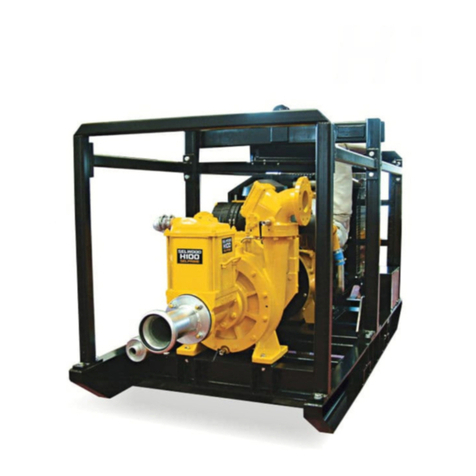
Selwood Spate PD75 Manual
4
1 GENERAL INFORMATION
1.1 Installation
1. The pump unit and its associated baseplate or
trolley mounting should be positioned on a firm
horizontal platform, and in the case of portable
units restrained from accidental movement.
2. If the pump is fitted with push-on type suction and
delivery spigots the hoses must be firmly secured
on these spigots with heavy duty clamps or clips
capable of withstanding the system operating
pressure. The integrity of the hose clamping
arrangements should be checked at regular daily
intervals in the case of static installations or
whenever the pump is repositioned in the case of
portable units. Similar precautions should be
taken with clamps securing multiple lengths of
hose on installation where long delivery and
suction lines are involved.
3. Delivery hose and any associated pipework
should be capable of withstanding the maximum
system operating pressure. Suction hose should
be of non-collapsible variety.
1.2 Operation
1. CAUTION The pump should only be
operated within the speed and pressure limits
detailed in the operating handbook for the model
in question.
2. If there is a danger of freezing, the fluid normally
retained within the pump between operating
cycles should be drained off through the drain taps
provided.
3. WARNING Positive displacement pumps
of the PD75 type should not be run against a
closed valve on the delivery side. If there is a
danger of high system pressures developing
because of closed delivery valves or some other
reasons the pump should be fitted with a full flow
relief valve adjusted to a lift at a safe working
pressure for the pump and pipework system.
4. Where protective caps are used to prevent
damage to the suction and delivery spigots during
storage or in transit they must be removed before
the pump is started up.
1.3 Maintenance
1. Inspection and maintenance. Regular flushing
after use and periodic stripping and inspection of
the cylinders will help maintain the PD75 in best
condition. All bearings are sealed for life so
lubrication is only necessary when re assembly of
the pistons to the connecting rods occurs. See
lubrication section for advice on products and
brands. Appropriate flushing with clean water after
use will further aid long service life. The engine or
driver should be maintained in accordance with
the manufacturer’s instructions.
2. Replacement parts. Only the manufacturers or
factory approved components should be used as
replacement parts and where necessary they
should be fitted with the assistance of the special
purpose tools indicated in the operating and
servicing manual.
3. All maintenance work must be carried out with the
pump and engine/motor stationary.
1.4 I.C. Engines
1. Where I.C. engines are used to power the pump
they have been mounted in accordance with the
engine manufacturers recommendations and
adequate guarding provided between the pump
and engine.
2. Exhaust and Exhaust Pipes. If there is a risk of
accidental contact by operators, the exhaust
system should be lagged or screened and the
outlet directed away from operators or other
persons likely to be nearby. Direct contact with
flammable materials of all types must be avoided.
The importance of adequate ventilation to ensure
removal of exhaust fumes when engines are
operated in enclosed or covered accommodation
cannot be overstressed. Engines should not be
run in hazardous explosive atmospheres.
3. Access and Operation. Ensure that the operator
can start, control and stop the engine easily by
making all controls readily accessible. Fit remote
controls if access is difficult. Follow the
instructions laid down in the engine
manufacturer's Operators Handbook for starting,
operating and stopping procedures.
4. Fuel. In addition to the fire hazard associated with
fuel and lubricating oils, preventative action is
necessary with respect to leakage, contamination
and bodily contact.
5. WARNING Electrical Connections. It is
essential that earth terminals are connected with
an absolutely sound earth point and care should
be taken to ensure that the correct sized
conductors are selected to suit the current and
distance it is to be carried.
1.5 Electric Motors
1. All electrical connections should be made with
adequately rated conductors and starters.
Isolators and other associated switchgear should
be of adequate capacity for the imposed power
loadings. All electrical equipment should be
adequately earthed. All connections to be made
by a qualified electrician to BS7671 latest revision.
2. WARNING Isolate the power supply
before carrying out any commissioning, servicing
or maintenance work on the pump or electric
motor.










































